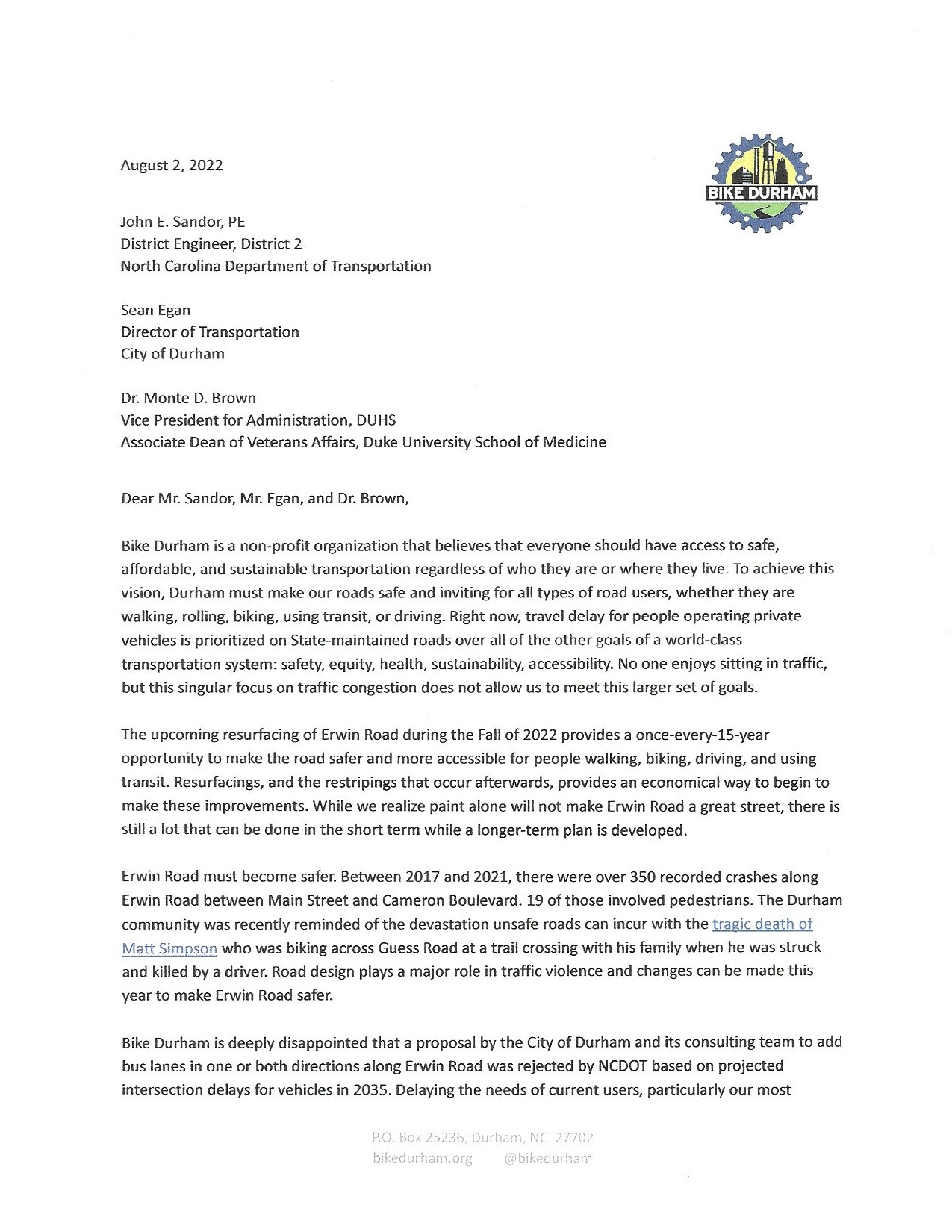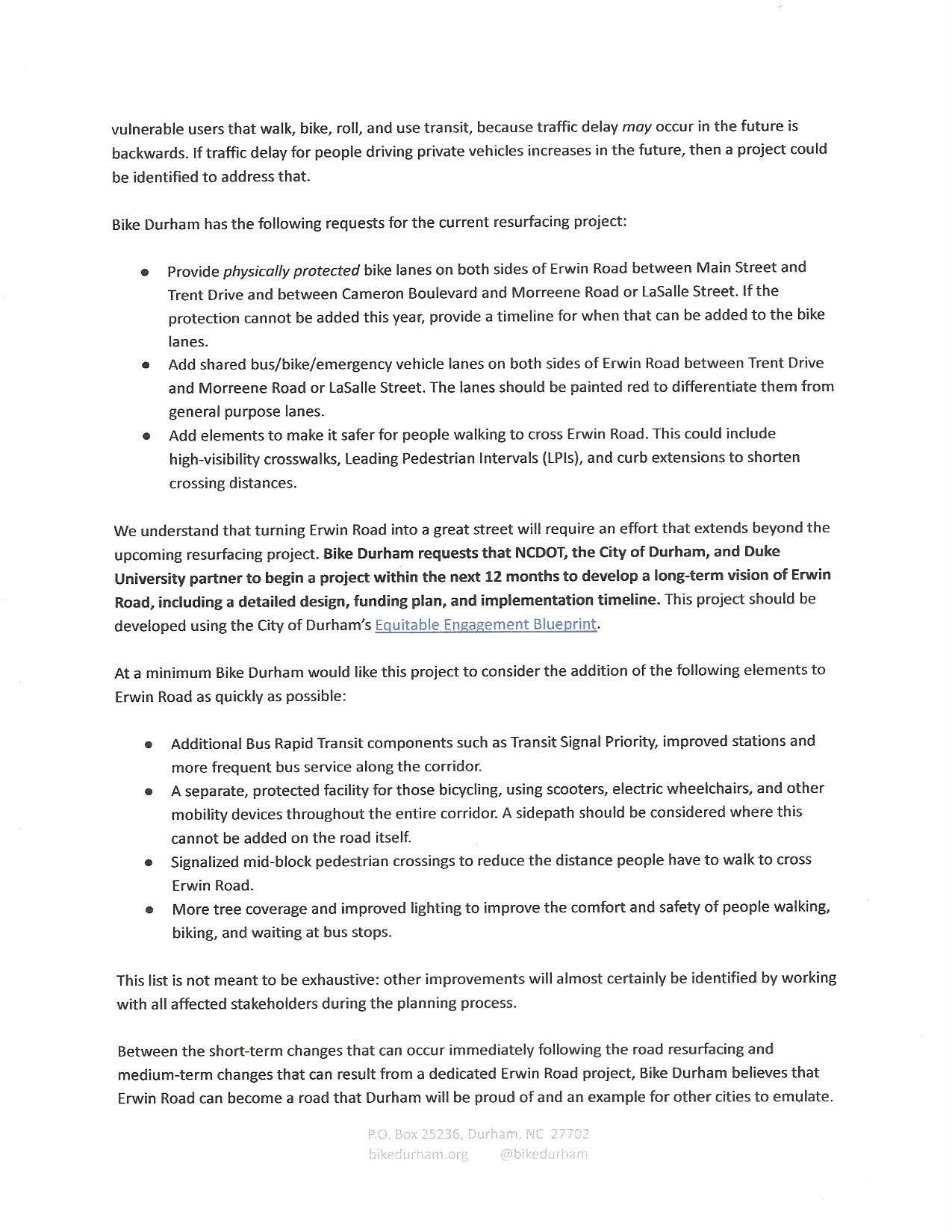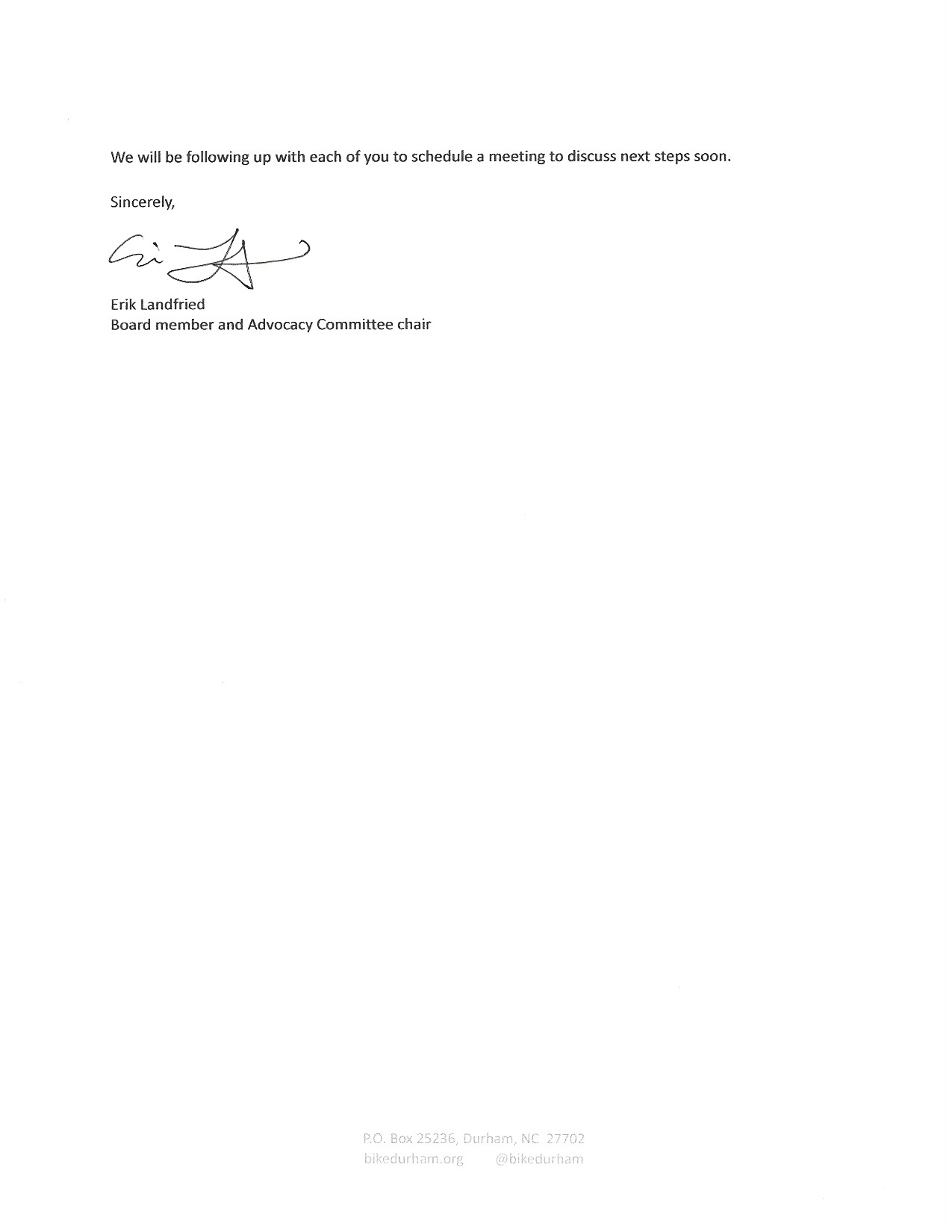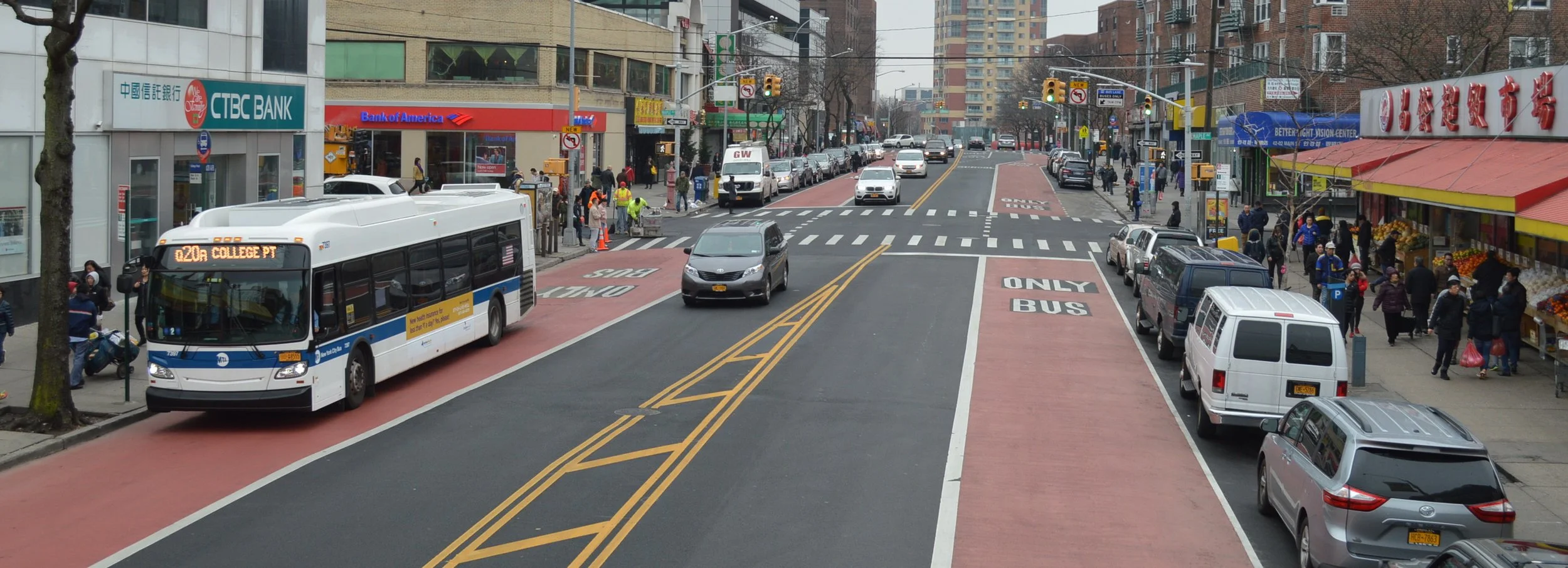Improvements on Erwin Road
While we did not get all the improvements that people walking, biking, and using transit on Erwin Road deserve, he City was able to convince NCDOT to approve several important safety improvements. The intersection of Erwin Road and Anderson Street includes the most visually noticeable changes. Read more here.
Bike Durham’s Open Letter to Local Officials on Erwin Road Repaving
On August 2, 2022, Bike Durham sent a letter to the local NCDOT district engineer, the City’s director of transportation, and the VP for Administration at the Duke University Health System. The letter outlines our disappointment with current restriping plans, which will essentially keep Erwin Road as-is rather than making it safer for all users. The text of the letter is below.



Creating a Better Erwin Road
Most people in Durham have likely experienced Erwin Road in some capacity, whether driving to a medical appointment at a Duke clinic, taking a bus to the VA Hospital, biking to work, or walking to class. This experience is generally not a positive one. The road is very wide, there are limited bike lanes, no bus lanes, and sidewalks are usually right up against the road, making it very unpleasant to walk. It is, like so many wide roads devoted mostly to private vehicles, dangerous. There were over 350 crashes on this corridor between 2017–21, including 19 involving people walking. Despite the presence of a pedestrian tunnel, the most crashes occurred at the intersections directly in front of Duke Hospital and the VA Hospital.
Source: Google Maps
The Previous Vision for Erwin Road
For most of the 2010s, the plan was to transform Erwin Road by adding a light rail line along it. Even then, many compromises had to be made because the North Carolina Department of Transportation (NCDOT), who owns and maintains Erwin Road, would not allow the removal of any general purpose lanes despite the fact that more people would be able to access the residential areas, restaurants, world-renowned medical services, and tens of thousands of jobs using transit. Still, light rail and associated improvements for people walking and biking along Erwin Road would have provided significantly better access for people living and working in the area.
Unfortunately, no comprehensive vision for Erwin Road has been developed since the light rail project ended over three years ago. One of the options shown to the public in the ongoing update to the Durham Transit Plan included a Bus Rapid Transit (BRT) line along Erwin Road. BRT, if done well, can mimic many of the best aspects of light rail. However, no work has yet been done to flesh out this concept and it’s not clear whether BRT along Erwin Road will make it into the final Transit Plan update or be anything more than a slight improvement over current bus service.
The Next Opportunity
The lack of a current vision for Erwin Road means that when opportunities arise, they are often missed. One such opportunity is occurring this fall when NCDOT will be repaving Erwin Road, something that last happened 15 years ago. Roads have to be restriped after they are paved, but they don’t have to be restriped the same way they were before. Durham has long taken advantage of this low-cost opportunity to repurpose excess space for private vehicles to create bike lanes, bus stops and better crosswalks. In fact, most of the existing bike lanes in Durham were created through repaving projects.
According to their own Complete Streets Guidelines, NCDOT is expected to consider improvements that will enhance the safety and access of those walking, biking, using transit, and driving:
They did not do so on Erwin Road and have not done so for any NCDOT-maintained road in Durham to our knowledge. NCDOT also moved the repaving of Erwin Road up a year, shortening the planning time for any restriping changes that could make the road safer, more accessible, and more inviting. The City of Durham and local transportation advocates recognized that an opportunity existed despite the short timeframe. Unfortunately, the City did not have staff capacity to do the necessary design work and public engagement in-house, so they hired a consultant. The scope of the contract focused mostly on potential transit improvements—a good start for sure—but did not include a more holistic set of potential improvements such as dedicated lanes for people biking.
To meet NCDOT’s requirements, the consultant had to determine whether these potential changes would cause traffic to be delayed at intersections in the year 2035. This nearly singular focus on intersection delay, often codified in a misleading concept called Level of Service, is problematic for a number of reasons. First, it assumes that other goals of a transportation system—safety, equity, health, sustainability, accessibility—are secondary to making sure people don’t have to hit the brake pedal for too long. Second, projecting future traffic delay relies on imprecise traffic models that will almost certainly be wrong. Just as no one would have predicted huge traffic decreases in 2020 due to a pandemic and shift to telework, no one knows what traffic will be like in 2035. Finally, these projections fail to take into account how many people will switch to walking, biking, and using transit when these modes of transportation become more enticing.
The initial ideas presented to NCDOT included bus lanes in both directions on Erwin Road or, if that was not feasible, a bus lane in either the eastbound or westbound direction.
Bus Only Lanes in New York City
Source: https://nacto.org/publication/transit-street-design-guide/transit-lanes-transitways/
All of these options were rejected by NCDOT because they do not believe there is enough spare capacity on Erwin Road to repurpose any lanes. In other words, NCDOT believes that the majority of road space on Erwin Road should continue to be for private vehicles and that even more road space would need to be created to accommodate other ways of moving around.
If Durham is going to get serious about addressing its transportation and sustainability goals, adding more asphalt is not the answer. We have to be more intentional about how we use the space that is already paved on our streets. On Erwin Road, that means carving out some of that space to make walking, biking, and using transit safer and more reliable.
As a reminder, these concerns about capacity are based on imprecise projections looking out thirteen years into the future. Remember also that this project only includes new pavement and new paint. If bus and/or bike lanes really create massive traffic jams, make the street less safe, or delay emergency vehicles in the future, they can quickly be converted back to general purpose lanes until a better solution can be found.
Unfortunately, the City and its consultants abandoned the idea of bus lanes and quickly shifted to looking at smaller improvements. These smaller improvements are still being developed but may include more and improved pedestrian crossings and queue jump lanes for buses. Queue jumps allow buses to use the right lane to move ahead of other traffic at certain intersections, which gives them a speed and reliability advantage over general traffic.
Source: https://nacto.org/publication/transit-street-design-guide/intersections/intersection-design/queue-jump-lanes/
A Vision for Erwin Road
While things like queue jump lanes would be welcome improvements, they fall far short of what Erwin Road needs to be. It is a big challenge for most people to envision what a street that’s existed in its current state for decades could potentially look like, so we asked for examples of great streets in front of major hospitals in North America. One of the best examples people sent us is Broadway in Seattle:
Source: Google Maps
Look at how much Seattle is able to accomplish in a much narrower space than Erwin Road! Two general purpose lanes w/streetcar tracks, a center turn lane, two-way cycle track, on-street parking, and wide sidewalks with street trees. This is a street that is safe and inviting for everyone who uses it, whether they are walking, riding in a wheelchair, biking, using transit, or driving.
Meanwhile, on Erwin Road…
Source: Google Maps
Despite being up to 60% wider than Broadway in Seattle, there is no protection for people biking, no priority for the thousands of people who use transit on Erwin Road every day, wide lanes that encourage speeding, and narrow sidewalks, oftentimes right up against that speeding traffic. A repaving will not create streetcar tracks or the curb between the cycle track and general travel lanes, but there is more than enough room for a shared bus/bike lane that can also be used by emergency vehicles if we decide to prioritize it.
Shared bus/bike lanes have become increasingly popular in the United States. They are not a perfect solution because of continued conflicts between cyclists and buses and where possible, both cyclists and buses should have their own dedicated lanes. However, it eliminates conflicts with the things that are the biggest safety hazard to cyclists and cause for delay for buses, which is cars. Despite an initial rejection from NCDOT engineers, the City should continue to push for these lanes and present them to the public for their consideration. The good news is that there is already an example of a shared bus/bike lane in North Carolina in Charlotte, so Durham does not need to reinvent the wheel:
Source: https://charlottenc.gov/newsroom/cityhighlights/Pages/Bus_bike_lane_debuts_on_4th_Street.aspx
What’s Next
Even if we can get bus and/or bike lanes and improved pedestrian crossings during this repaving, that will not be the end of the story. Paint alone is not going to create a safe, accessible, and beautiful Erwin Road. The City, NCDOT, and key stakeholders along the corridor like Duke University, Duke Hospital, and the VA Hospital must commit to developing a long-term plan for the road and figure out how to fund its construction. But we can also do a lot now to make significant progress towards making Erwin a road Durham can be proud of.
Last year, Bike Durham called for a bold vision of Zero Carbon Emissions, Zero Deaths or Serious Injuries, and Zero Racial or Economic Disparity of Access as the major goals of a regional 2050 transportation plan, which was adopted by local elected officials. Now it’s time to make that vision a reality. You can support us by signing up for updates on the Erwin Road repaving project. Public engagement is scheduled to begin in July and time will be of the essence, so we will need your voices.
Click this button to receive updates on Erwin Road, including information about public meetings and ways to provide input online.








